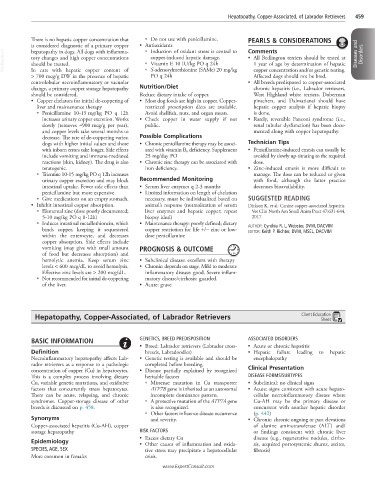Page 936 - Cote clinical veterinary advisor dogs and cats 4th
P. 936
Hepatopathy, Copper-Associated, of Labrador Retrievers 459
There is no hepatic copper concentration that ○ Do not use with penicillamine. PEARLS & CONSIDERATIONS
is considered diagnostic of a primary copper • Antioxidants Comments
○ Induction of oxidant stress is central to
VetBooks.ir tory changes and high copper concentrations ○ Vitamin E 10 IU/kg PO q 24h • All Bedlington terriers should be tested at Diseases and Disorders
hepatopathy in dogs. All dogs with inflamma-
copper-induced hepatic damage.
1 year of age by determination of hepatic
should be treated.
In cats with hepatic copper content of
PO q 24h
Affected dogs should not be bred.
> 700 mcg/g DW in the presence of hepatic ○ S-adenosylmethionine (SAMe) 20 mg/kg copper concentration and/or genetic testing.
centrolobular necroinflammatory or vacuolar • All breeds predisposed to copper-associated
change, a primary copper storage hepatopathy Nutrition/Diet chronic hepatitis (i.e., Labrador retrievers,
should be considered. Reduce dietary intake of copper. West Highland white terriers, Doberman
• Copper chelators for initial de-coppering of • Most dog foods are high in copper. Copper- pinschers, and Dalmatians) should have
liver and maintenance therapy restricted prescription diets are available. hepatic copper analysis if hepatic biopsy
○ Penicillamine 10-15 mg/kg PO q 12h Avoid shellfish, nuts, and organ meats. is done.
increases urinary copper excretion. Works • Check copper in water supply if not • Rarely, reversible Fanconi syndrome (i.e.,
slowly (removes ≈900 mcg/g per year), public. renal tubular dysfunction) has been docu-
and copper levels take several months to mented along with copper hepatopathy.
decrease. The rate of de-coppering varies; Possible Complications
dogs with higher initial values and those • Chronic penicillamine therapy may be associ- Technician Tips
with inborn errors take longer. Side effects ated with vitamin B 6 deficiency. Supplement • Penicillamine-induced emesis can usually be
include vomiting and immune-mediated 25 mg/day PO avoided by slowly up-titrating to the required
reactions (skin, kidney). The drug is also • Chronic zinc therapy can be associated with dose.
teratogenic. iron deficiency. • Zinc-induced emesis is more difficult to
○ Trientine 10-15 mg/kg PO q 12h increases manage. The dose can be reduced or given
urinary copper excretion and may block Recommended Monitoring with food, although the latter practice
intestinal uptake. Fewer side effects than • Serum liver enzymes q 2-3 months decreases bioavailability.
penicillamine but more expensive • Limited information on length of chelation
○ Give medications on an empty stomach. necessary, must be individualized based on SUGGESTED READING
• Inhibit intestinal copper absorption. animal’s response (normalization of serum Dirksen K, et al: Canine copper-associated hepatitis.
○ Elemental zinc (dose poorly documented; liver enzymes and hepatic copper; repeat Vet Clin North Am Small Anim Pract 47:631-644,
5-10 mg/kg PO q 8-12h) biopsy ideal) 2017.
○ Induces intestinal metallothionein, which • Maintenance therapy: poorly defined; dietary AUTHOR: Cynthia R. L. Webster, DVM, DACVIM
binds copper, keeping it sequestered copper restriction for life +/− zinc or low- EDITOR: Keith P. Richter, DVM, MSEL, DACVIM
within the enterocyte, and decreases dose penicillamine
copper absorption. Side effects include
vomiting (may give with small amount PROGNOSIS & OUTCOME
of food but decreases absorption) and
hemolytic anemia. Keep serum zinc • Subclinical disease: excellent with therapy
levels < 600 mcg/dL to avoid hemolysis. • Chronic: depends on stage. Mild to moderate
Effective zinc levels are > 200 mcg/dL. inflammatory disease: good. Severe inflam-
○ Not recommended for initial de-coppering matory disease/cirrhosis: guarded.
of the liver. • Acute: grave
Hepatopathy, Copper-Associated, of Labrador Retrievers Client Education
Sheet
BASIC INFORMATION GENETICS, BREED PREDISPOSITION ASSOCIATED DISORDERS
• Breed: Labrador retrievers (Labrador cross- • Acute or chronic hepatitis
Definition breeds, Labradoodles) • Hepatic failure leading to hepatic
Necroinflammatory hepatopathy affects Lab- • Genetic testing is available and should be encephalopathy
rador retrievers as a response to a pathologic completed before breeding. Clinical Presentation
concentration of copper (Cu) in hepatocytes. • Disease partially explained by recognized
This is a complex process involving dietary heritable factors DISEASE FORMS/SUBTYPES
Cu, variable genetic mutations, and oxidative ○ Missense mutation in Cu transporter • Subclinical: no clinical signs
factors that concurrently stress hepatocytes. ATP7B gene is inherited as an autosomal • Acute: signs consistent with acute hepato-
There can be acute, relapsing, and chronic incomplete dominance pattern. cellular necroinflammatory disease where
syndromes. Copper-storage disease of other ○ A protective mutation of the ATP7A gene Cu-AH may be the primary disease or
breeds is discussed on p. 458. is also recognized. concurrent with another hepatic disorder
○ Other factors influence disease occurrence (p. 442)
Synonyms and severity. • Chronic: chronic ongoing or past elevations
Copper-associated hepatitis (Cu-AH), copper of alanine aminotransferase (ALT) and/
storage hepatopathy RISK FACTORS or findings consistent with chronic liver
• Excess dietary Cu disease (e.g., regenerative nodules, cirrho-
Epidemiology • Other causes of inflammation and oxida- sis, acquired portosystemic shunts, ascites,
SPECIES, AGE, SEX tive stress may precipitate a hepatocellular fibrosis)
More common in females crisis.
www.ExpertConsult.com

